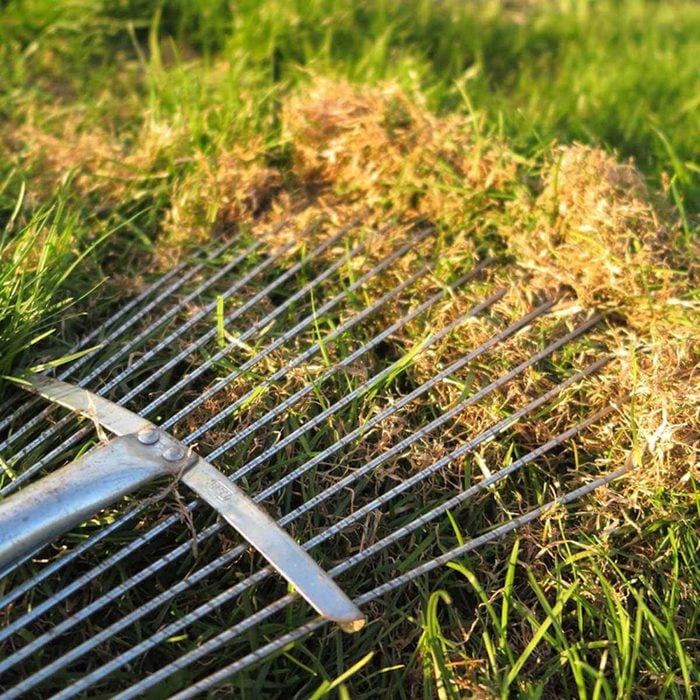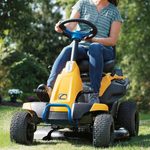Tips on How to Dethatch a Lawn

Give your grass a boost this spring by tackling any problematic thatch buildup. Here's a complete guide to dethatching for a lush and hearty lawn.
Our editors and experts handpick every product we feature. We may earn a commission from your purchases.
You may be meticulous about mowing, weeding, seeding and watering your lawn, but still find it lackluster in color and health. “Don’t blame your efforts,” says Midwest Lawn Co. owner Eric Harbit. “Blame thatch.”
Many homeowners don’t know their lawn may be compromised by a hidden enemy. Thatch, a dense layer of organic material — including live and dead grass, roots, leaves, stems and weeds — covers the surface of the soil. It acts as an impenetrable barrier that blocks adequate amounts of air, water and nutrients from reaching the roots of your grass.
This lawncare oversight is rapidly changing, however. Online searches for dethatching-related information and tips have more than doubled since 2019. Increasing numbers of homeowners are realizing they need to add dethatching to their regular lawn care schedule.
“Dethatching is the mechanical removal of thatch, usually with a gasoline-powered machine but it can also be done with a leaf rake or thatching rake,” says agronomist and lawn care expert Bob Mann, director of state and local government relations for the National Association of Landscape Professionals.
If you are planning to remove excess thatch this spring, read on to learn how to properly dethatch your lawn and ensure lasting vigor and vibrancy.
On This Page
When to Dethatch Your Lawn
The best time to dethatch your lawn is while the grass is still in the process of growing and the soil is most, but not soggy. That means for cool-season grasses, you’ll probably want to dethatch in the spring. For warm-season grasses, you’re probably looking at late spring or early in the summer.
Methods for Dethatching a Lawn
There are various methods to dethatch your lawn, depending upon how large an area you need to cover and how dense the thatch layer has become. Here are a few of the most common:
Dethatching rakes
A dethatching rake is a short-tined rake with thin, sharp blades designed to dig into your turf and pull up thatch. Dethatching rakes are effective for light thatch maintenance on small lawns or sections of lawn. A dethatching rake is suitable “for gardeners that want a vigorous upper body workout,” as Mann puts it.
If you have limited thatch, you can also use a standard bow rake. “The same leaf rake that you use in the fall can be used to remove a degree of thatch from the lawn,” Mann says. “It’s not easy, but it is doable.”
Dethatching machines
Dethatching machines resemble push lawn mowers and come in two basic types, Mann says.
“First is a series of thin metal blades mounted vertically on a spinning horizontal shaft turned by a gasoline engine,” he says. “The blades are set to cut deep enough to go through the thatch layer and just into the topsoil. A proportion of the thatch is brought to the surface (it looks just like grass clippings) where it can be gathered and removed.”
This type of dethatching machine, also known as a scarifier, is the most effective method for removing deep or dense thatch. It is also the most aggressive method and should be used with caution on lawns that are not in vigorous health. Dethatching machines with blades are typically found at equipment rental stores, although you can also purchase a gas- or electric-powered scarifier if your lawn requires annual dethatching.
The second type, Mann says, “is a series of spring-loaded tines on a bar that is moved over a lawn by a machine, typically a mower. The tines are set to dig into the thatch as the machine travels across the lawn tearing out a proportion of it and depositing it on the surface. This approach is less traumatic, but also less effective.”
Also known as power rakes, these work well for lawns with thinner thatch layers and healthy grass that can withstand intense raking. Power rakes are commonly used by landscapers to remove loose thatch, allowing air and light to penetrate to the grass roots. They can also be rented or purchased for DIY dethatching.
Dethatching tow-behinds
If you have a large area that needs dethatching and you own a tractor, rider or ATV, a tow-behind dethatcher is ideal. Fitted with sturdy tines, these dethatchers comb through the matted layer of thatch while being towed across your lawn.
Many tow-behinds include an adjustable weight tray for more or less penetration into the soil. Use light weights to skim the soil surface for annual thatch maintenance, or heavier weights to turn your tow-behind into a scarifier to remove dense thatch across a wide area.
Dethatching liquids
A relative newcomer to the dethatching scene, dethatching liquids combine bacteria and enzymes to boost the natural decomposition of the thatch layer. Instead of removing the thatch, you can simply mix a dethatching liquid with water and spray it on your lawn.
Some liquid dethatchers also incorporate lawn fertilizer to combine two jobs into one. There are also DIY liquid dethatchers you can mix at home with ingredients ranging from soap to beer, supposedly formulated to speed thatch decomposition.
It’s not clear how effective dethatching liquids are in reducing or preventing thatch build-up. Opt for a rake or mechanical dethatcher for more effective results.
How to Prep for Dethatching Your Lawn
-
Dethatch when your soil is moist but not soggy, so water your lawn thoroughly two days before you plan to dethatch.
-
If you’re using a dethatching machine, be sure to mark any shallow irrigation lines, sprinkler heads or buried utility lines before starting.
-
Mow your lawn to half its normal height before dethatching.
-
If you are renting a dethatching machine, ask the rental agency to adjust the spacing and cutting depth for your grass type. The blades or tines should be set to cut no deeper than 1/2 inch into the soil. And get detailed directions on how to use the machine. Keep in mind dethatching machines can be heavy, so transport it on a truck or large van and enlist a buddy to help you load and unload it.
Tools for Dethatching the Lawn
“Just as in cooking, have all of your tools and materials ready to go before starting,” Mann says. “The machine is going to bring up much more material than you might think. Have a nice big leaf rake to (rake the removed thatch into a row), a good-sized wheelbarrow to transport it and a suitable place to dump it on your property.”
And, Mann adds, “Don’t enter this thatch into the waste stream if at all possible. It doesn’t decompose quickly and we certainly want to be responsible with yard waste.”
Note: Run the dethatching machine over your yard at least three times, in different directions each time. The machine should churn up roughly the same volume of organic debris each time you pass.
Aftercare
Dethatching will probably leave your lawn looking a little worse for wear for a few weeks. Regardless which dethatching method you choose, bolster your lawn immediately with quality fertilizer and a deep watering. Your grass will need some TLC to bounce back as vibrant and resilient as before.
“This is major surgery for your lawn,” Mann says. “There will be a period of time necessary for recovery where you might want to go above and beyond.”



